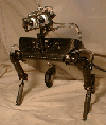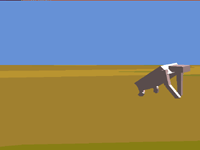
Charlie Kemp

A well-designed computational infrastructure will help us to organize the requisite computation and allow us to more easily add functionality to Coco. For example, along with other code we would like Coco's brain to simultaneously run a variety of real-time vision algorithms, audio processing algorithms, tactile information processing algorithms and motor control algorithms. Without a framework for making these algorithms work together the effort spent maintaining the system, let alone producing new research at the creature level, would be infeasible.

Juan D. Velasquez
Recently, efforts have shifted from behavior-based approaches to robotics that deal with insect-level competence, to those that try to build humanoid robots with an increasingly complex behavioral repertoire that includes, among other competences, the ability to interact socially.
If we are to build robots that exhibit robust and adaptive behavior, and which are responsive to social interactions, then we must deal with issues such as motivation and emotion, which have not been considered essential in previous behavior-based robotics, but which are crucial in humanoid robotics.
Charlie Kemp

By using more recent signal processing techniques in conjunction with an updated representational framework, the benefits of medial axis representations can be exploited while avoiding several of their traditional drawbacks. Some types of medial axis representations appear to be well matched to the class of shapes that comprise human faces and bodies. These descriptors highlight the underlying structure of the overall shape, while also representing important multi-scale aspects of the component shapes. As an intuitive example, a stick figure representation of a human body does a good job of encoding the body's configuration with respect to the world and the observer. Furthermore, each part of the stick figure can describe a component shape of the body at some scale, such as an elongated rectangular shape for the torso and legs, and two smaller tapering tubes for the legs.
Christopher Morse

Artificial social behavior models require a platform that provides both sensory input and a medium for behavioral output. The amount and quality of sensory information provided to the software directly impacts performance and capabilities for further development. In the same way, the repertoire of expression directly effects how well the system will be perceived to be working. A mobile platform adds an entirely new dimension to both the sensory systems and behavior generation by allowing everything the robot senses and does to be related to physical position. Human factors also play into the success of a particular behavior model; if people have difficulty interacting with the platform then the abilities of the model will be put at a disadvantage.
Eduardo Torres-Jara

[Current Research], [Future Work], [Humanoid Robotics Group Home], [Introduction], [People],
[Publications], [The Robot], [Video]
webmaster: annika